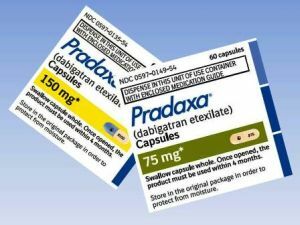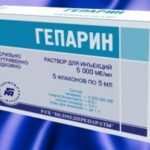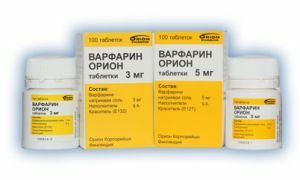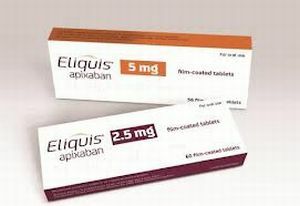 Drugs that can slow down the work of the human blood coagulation system are called anticoagulants .
Drugs that can slow down the work of the human blood coagulation system are called anticoagulants .
Their action is caused by inhibition of the metabolism of those substances that are responsible for the production of thrombin and other components capable of forming a thrombus in the vessel.
They are used in many diseases, during which, the risk increases of a blood clot in the venous system of the lower limbs, cardiovascular system of the heart and lungs.
Content
- History of discovery
- Direct and indirect anticoagulants
- Anticoagulants new generation
- Pros and cons of drugs of the new generation
- PLA
- indirect PLA direct
- Dabigatran
- Rivaroxaban
- apixaban
- Edoksaban
- Feature receiving these drugs
- Conclusions
History of discovery
history anticoagulantsbegan in the early twentieth century. In the fifties of the last century, the medicine world has already received a medicine capable of liquefying blood, with the active substance coumarin.
The first patented anticoagulant was Warfarin ( WARFARIN) and was intended solely for baiting of rats, since the drug was considered extremely toxic to humans.
So in 1955 Warfarin began to be prescribed to patients who underwent myocardial infarction. And to this day Warfarin ranks 11th among the most popular anticoagulants of our time.
Direct and indirect anticoagulants

Anticoagulants of direct and indirect action - indispensable drugs in medicine
Anticoagulants are chemicals that can change the viscosity of blood, in particular, inhibit coagulation processes. Depending on. ..
Anticoagulants of the new generation
But pharmaceutical progress does not stand still. The development of a better and effective anticoagulant, with a minimum of contraindications and side effects, was conducted and continues to be conducted, with no need to monitor the INR and others.
Over the past twenty years, preparations of the new generation of anticoagulants have appeared.
Consider their mechanism of action, and the main differences in comparison with their predecessors.
First of all, when synthesizing new drugs, scientists are trying to achieve the following improvements:
- versatility, that is, the ability to take one drug for different diseases;
- presence of oral form;
- increasing the manageability of hypocoagulation, minimizing additional control;
- no need to adjust the dose;
- extending the range of potential patients for whom taking this medication is necessary, but was contraindicated;
- possibility of taking anticoagulant by children.
Some new oral anticoagulants have a completely unique effect on the blood coagulation system. 
And also affect other clotting factors, unlike other drugs.
For example, newly synthesized substances interact with P2Y12 ADP-receptor platelets, inhibit the FXa factor, Xa, are IgG-class immunoglobulins, and so on.
Pros and cons of the new generation
NOA( new oral anticoagulants) have several advantages over their predecessors. Depending on the preparation and its group, the following positive innovations exist:
- reduced incidence of intracranial and fatal bleeding;
- frequency of embolism is not higher in predecessors, and sometimes lower;
- the possibility of the safe reception of PLA if Warfarin is prohibited;
- fast start and termination( about two hours);
- reversible inhibition of free thrombin-binding factor and thrombin itself;
- absence of interaction with oocaocalcin and GLA-protein;
- low effect of food and other drugs used;
- a short half-life( about 5-16 hours).
However, there are a number of shortcomings in modern anticoagulants, such as:
- The need for regular intake of certain LOA.Some old anticoagulants made it possible to skip a few receptions, since they had a prolonged effect, which did not result in a sharp change in blood counts.
- Absence of validated tests for an emergency discontinuation of anticoagulant therapy or for monitoring adherence to therapy.
- Availability of a large number of tests for each of the new anticoagulants.
- Intolerance of some new drugs in patients who, without side effects, have taken similar anticoagulants of the older generation.
- There may be an increased risk of gastrointestinal bleeding.
- High cost.
 Innovative cream for the prevention and treatment of varicose varicobusters - you need to know.
Innovative cream for the prevention and treatment of varicose varicobusters - you need to know. How to apply medical varifort is most effective and safe. Tips and instructions, reviews and analysis, and much more in our material.
Non-direct action
New anticoagulants of indirect effect in one way or another affect the metabolism of vitamin K.
All anticoagulants of this type are divided into into two groups: monocoumarins and dicoumarins.
At one time, such drugs as Warfarin, Cincumar, Dicumarin, Neodikumarin and others were developed and released.
Since then, there have been no cardinally new substances that affect the level of vitamin K.
Anyone who takes an indirect anticoagulant should:
- calculate the daily intake of vitamin K;
- regularly monitor the INR;
- have the ability to change the level of hypocoagulation in intercurrent diseases;
- monitor for possible sudden emergence of symptoms of internal bleeding, which immediately call the doctor and move in the near future to another group of anticoagulants.
But anticoagulants are not strictly classified into direct or indirect drugs. There are several groups of substances that have properties to dilute, in one way or another, blood. For example, enzyme anticoagulants, inhibitors of platelet aggregation and others.
So in the market there was a new antiaggregant Brilinta .The active substance is ticagrelor. A representative of the class of cyclopentyltriazolopyrimidines is a reversible P2Y receptor antagonist.
Direct acting
The following drugs are classified as new anticoagulants of indirect effect.
Dabigatran

New anticoagulant direct thrombin inhibitor. Dabigatran etexilate is a low molecular weight precursor of the active form of dabigatran. The substance inhibits free thrombin, fibrin-binding thrombin and platelet aggregation.
The most commonly used for the prevention of venous thromboembolism , in particular, after arthroplasty of joints.
In pharmacies, you can find a medicine with the active substance dabigatran - Pradaksa. It is available in the form of capsules, containing 150 mg dabigatran etexilate in one capsule.
Rivaroxaban
High selective factor Xa inhibitor. Rivaroxaban is able to dose-dependently increase APTTV and the result of HepTest. Bioavailability of the drug is about 100%.Does not require monitoring of blood parameters. Variational coefficient of individual variability is 30-40%.
One of the brightest representatives of the preparation containing rivaroxaban is Xarelto. Produced in tablets of 10 mg of active substance in each.
Apixaban
The drug may be administered to patients who are not receiving vitamin K antagonists.
Compared to acetylsalicylic acid, it has a low probability of embolism. Apixaban selectively inhibits FXa coagulation factor. Basically, it is prescribed after a planned endoprosthesis of the knee or hip joint.
Produced under the name Eliksvis. Has an oral form.
Edoxaban
The drug belongs to the latest class of high-speed factor Xa inhibitors. As a result of clinical studies, it was found that Edoxaban has the same ability to prevent the formation of thrombi with Warfarin.
At the same time it has a significantly lower probability of bleeding.
The characteristic of taking these medications
 should be used with caution in prescribing elderly patients with , with a significant deviation of weight from the norm, with a disruption in the function of the kidneys, diseases associated with improper functioning of the circulatory system.
should be used with caution in prescribing elderly patients with , with a significant deviation of weight from the norm, with a disruption in the function of the kidneys, diseases associated with improper functioning of the circulatory system.
One of the characteristics of many new anticoagulants is their speed and fast half-life. This suggests that it is necessary to be extremely careful in observing the regimen of taking tablets. Since even skipping one tablet can lead to complications.
For bleeding, as a result of therapy with some anticoagulants, there is a specific treatment.
For example, with bleeding due to Rivaroxaban, the patient is prescribed a prothrombin concentrate or freshly frozen plasma. When blood loss due to Dabigatran is carried out hemodialysis, recombinant FVIIa.
Conclusions
The development of new anticoagulants continues to this day. There are still problems with side effects in the form of bleeding.
Even some new preparations require monitoring.
The number of contraindications, although reduced, but not completely eliminated. Some drugs still have slightly increased toxicity.
Therefore, scientists continue to search for a universal tool that has high bioavailability, lack of tolerance, absolute safety and intellectual regulation of the level of prothrombin in the blood, depending on other factors affecting it.
An important aspect is the presence of an antidote in the preparation, if necessary, of an immediate operation.
Nevertheless, the new drugs, in comparison with the preparations of the last century, have very noticeable positive differences, which indicates the titanic work of scientists.
